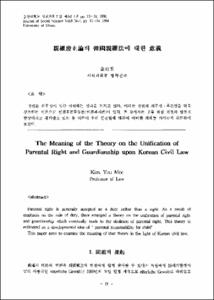중추신경계 생식세포종양
- Alternative Title
- Germ cell tumors of the central nervous system
- Abstract
- To elucidate the clinicopathological characteristics of the intracranial germ cell tumors, retrospectively examined were 13 cases that were histologically confirmed in Asan Medical Center between January 1990 and August 1992. Germ cell tumors of the central nervous system consisted of 10 cases of germinomas, one cases of endodermal sinus tumor, one embryonal carcinoma, and one mixed germ cell tumor(immature teratoma + choriocarcinoma + embryonal carcinoma).
All the germinomas presented during the first three decades of life, and they were most common in the second decade with median age of 12 and were equally divided between the sexes. Germinomas were located almost exclusively in midline structures, particularly suprasellar area and/or pineal region. Occasionally, germinomas occured away from the midline in such sites as the thalamus or basal ganglia. in the suprasellar location the triad of diabetes insipidus, visual defect and hypopituitarism was typically produced. Cytological examinations of CSF or intraoperative aspiration were much useful in the diagnosis of germinomas.
Histological features of the germ cell tumors were generally agreed with serum or CSF levels of tumor markers such as HCG, AFP and CEA. However, two of ten germinomas disclosed discrepency between them. Therefore, stressed was the importance of collective consideration for both tissue diagnosis and tumor marker studies.
Most germ cell tumors responded to radiation therapy with or without adjuvant chemotherapy following initial surgical biopsy, at least for the short-term follow-up periods.
To elucidate the clinicopathological characteristics of the intracranial germ cell tumors, retrospectively examined were 13 cases that were histologically confirmed in Asan Medical Center between January 1990 and August 1992. Germ cell tumors of the central nervous system consisted of 10 cases of germinomas, one cases of endodermal sinus tumor, one embryonal carcinoma, and one mixed germ cell tumor(immature teratoma + choriocarcinoma + embryonal carcinoma).
All the germinomas presented during the first three decades of life, and they were most common in the second decade with median age of 12 and were equally divided between the sexes. Germinomas were located almost exclusively in midline structures, particularly suprasellar area and/or pineal region. Occasionally, germinomas occured away from the midline in such sites as the thalamus or basal ganglia. in the suprasellar location the triad of diabetes insipidus, visual defect and hypopituitarism was typically produced. Cytological examinations of CSF or intraoperative aspiration were much useful in the diagnosis of germinomas.
Histological features of the germ cell tumors were generally agreed with serum or CSF levels of tumor markers such as HCG, AFP and CEA. However, two of ten germinomas disclosed discrepency between them. Therefore, stressed was the importance of collective consideration for both tissue diagnosis and tumor marker studies.
Most germ cell tumors responded to radiation therapy with or without adjuvant chemotherapy following initial surgical biopsy, at least for the short-term follow-up periods.
- Issued Date
- 1992
- Type
- Research Laboratory
- Alternative Author(s)
- Choe, Gheeyoung; Gong, Gyeongyeob; Lee, Jung Kyo; Whang, Chung Jin; Yu, Eunsil; Lee, Inchul
- Publisher
- 울산의대학술지
- Language
- kor
- Rights
- 울산대학교 저작물은 저작권에 의해 보호받습니다.
- Citation Volume
- 1
- Citation Number
- 1
- Citation Start Page
- 159
- Citation End Page
- 167
- Appears in Collections:
- Research Laboratory > The ULSAN university medical journal
- 파일 목록
-
-
Download
 000002024892.pdf
기타 데이터 / 627.04 kB / Adobe PDF
000002024892.pdf
기타 데이터 / 627.04 kB / Adobe PDF
-
Items in Repository are protected by copyright, with all rights reserved, unless otherwise indicated.